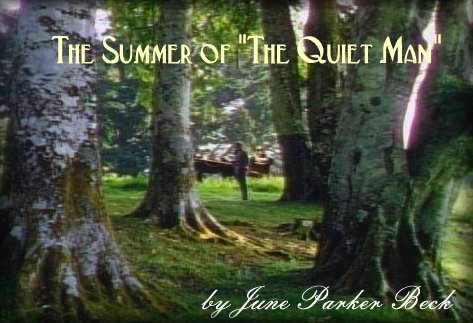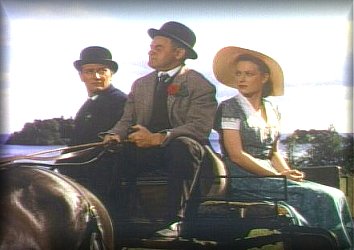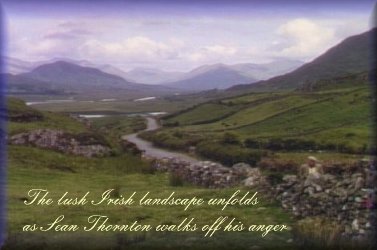
Authors and journalists have, for the last 49 years attempted to analyze and review "The Quiet Man" with some kind of unique and personal slant. There are extensive publications on Ford's life, his films and his talent. They analyze and dissect - they have seminars and film festivals. Some even break it down frame by frame...just in case the less astute viewer might have missed some insignificant little glitch or flaw. Even more confusing is the sharing of some far-fetched personal insight or theory that the writer feels is obvious - again, only to those who are truly attune to the messages of the film, the actors, the director, the writers, etc. Some authors read in subliminal "symbols" and melodramatic speculations as to what Ford was thinking or why he did this...or that. Some even get into camera angles.
Thank heavens over and above it all there remains this glorious and enchanting love story that John Ford had to pursue for over 14 years before it became a cinema reality.
Another "reality" was a group called "The Ford Stock Company." This was an extremely elite clan of John Ford favorites - actors whose gifts he recognized and molded to their full potential. They were a circle of tremendously talented, seasoned professionals who were tough enough to deal with Ford's eccentricities and smart enough to recognize his genius. Then, for as many cinema projects as possible, Ford surrounded himself by his select group. He knew these actors and crew could help him deliver a motion picture that brought into play every quirk of his own personality and a film to please Ford as well as his audience. No fanfare for this director - he made a film and it was done, he moved on. He was in the movie business. Simple as that. In between times he delighted in toying with reporters and journalists, making interviews a challenge, if not impossible. On one occasion a journalist asked him how he shot a particular scene. Ford quipped, "With a camera." At one point after the first screening of the film Ford reportedly said, "I think even the Irish may like it."
When Ford's dream project of what some studios thought was a "silly little Irish story" began to materialize that summer of 1951, it had definitely come a long way and a lot of years to get to that point. Even after finally getting a studio to produce the film there was a myriad of variables that have to come together. First Ford had to yield to producer Herb Yates' demand that they first make a western "Rio Grande" to make up for the money Yates was so sure he would lose on the subsequent film, "Quiet Man." Another major issue which was ever present is if his stars, John Wayne and Maureen O'Hara, et. al. could all coordinate their schedules and previous contractual obligations to make themselves available to even do the film. Maureen, herself, finished "Flame of Araby" and after her last scene went right from the set to the airport to fly to Ireland. It had been a long time since 1945 when Maureen had made a hand-shake agreement with Ford to play the female lead in "The Quiet Man." She used to joke that if they didn't hurry up and get it produced she and Duke would have to play the roles of Widow Tillane and Red Will Danaher.

You can imagine the impact the arrival of a movie crew had on a little Irish village. They were even without electricity in that area in 1951 so generators had to be brought over for lighting and sound. Even with all the elaborate advanced preparations that took place in Ireland and America before the players and crew arrived, the excitement must have been overwhelming. I'm sure not all of the villagers shared the enthusiasm, but the endeavor did provide many jobs for locals.
 For
Maureen it had special meaning because she was 'going home.' She, of
course, took her 7 year old daughter Bronwyn with her and was able to have
a reunion with her family, who lived in a suburb of Dublin. John Wayne
brought his four children and wife, Chata. The other Irish players
who were successful actors in America, Barry Fitzgerald and his brother Arthur
Shields, were equally at home again. Sean McClory, also of Irish heritage,
was in scenes that were filmed in the U.S. Victor McLaglen was, in
fact, born in Tunbridge Wells, England, one of 8 sons of an Anglican
clergyman. A group of Abbey players were included in the cast
and locals were used as stand-ins for the various stars. There is a
very distinct difference between a "stand-in" and a "double." A stand-in
'stands there' while the lights and scene is set up (which can take quite
a long time) so the star does not have to endure the tiresome task.
No special talent is needed except, perhaps to be of reasonably the same
height and stature as the star. A "double" is generally referred to
when doing stunts that are too risky for the stars to do.
For
Maureen it had special meaning because she was 'going home.' She, of
course, took her 7 year old daughter Bronwyn with her and was able to have
a reunion with her family, who lived in a suburb of Dublin. John Wayne
brought his four children and wife, Chata. The other Irish players
who were successful actors in America, Barry Fitzgerald and his brother Arthur
Shields, were equally at home again. Sean McClory, also of Irish heritage,
was in scenes that were filmed in the U.S. Victor McLaglen was, in
fact, born in Tunbridge Wells, England, one of 8 sons of an Anglican
clergyman. A group of Abbey players were included in the cast
and locals were used as stand-ins for the various stars. There is a
very distinct difference between a "stand-in" and a "double." A stand-in
'stands there' while the lights and scene is set up (which can take quite
a long time) so the star does not have to endure the tiresome task.
No special talent is needed except, perhaps to be of reasonably the same
height and stature as the star. A "double" is generally referred to
when doing stunts that are too risky for the stars to do.
Notes of Interest:
The script for "The Quiet Man" was actually written for an American audience - obviously the logical box office to target. So if you are looking for frame-to-frame Irish authenticity - this is not the movie. If you're looking for a cinema masterpiece of lush Irish countryside and a fabulous love story, this is the picture. It was meant to be a fairy tale Ireland and to tell a sensual love story. The original story was written by an Irishman...the adaptation was written by Americans and Irish-Americans.
The film running time of 129 minutes was not acceptable to Herb Yates, Republic mogul. He felt it was far too long and wanted it cut to 120 minutes. So, the ever cunning Ford proved further his craftiness at a 1951 screening at Republic Studios specifically for theater exhibitors. Ford, of course, did not cut the film down but when they hit the 120 minute mark the camera stopped and the screen went blank. The audience of exhibitors went wild because it was in the fight sequence and they wanted to see the rest of it. Herb Yates had no choice but to relent and let them see the rest of the movie...they LOVED it. Of course, no way after the movie was viewed in its entirety could Yates dare to cut even one frame.
There also seems to be an elusive documentation of the date of the actual release of the movie. Most insist it was 1952. However, the Academy holds the award ceremonies in March and this it to recognize films, cast, crew, etc. for films completed the preceding year. To be eligible for the 1952 awards ceremonies...it would have had to be released officially somewhere in 1951. (I don't think the 1951 screening for theater exhibitors would count). The showing at the Capital Theater in New York was in 1952. "The Quiet Man" was nominated for Academy Awards in 1952 for "Best Picture" - "Best Supporting Actor - Victor McLaglen," "Best Director - John Ford," "Best Screenplay - Frank S. Nugent," "Best Colour Cinematography Winton C. Hoch and Archie Stout, "Best Art-Direction, Set Decoration, Colour: Frank Hotaling, John McCarthy Jr., Charles S. Thompson, and "Best Sound Recording: Republic Sound Department, Daniel J. Bloomberg." Only Director John Ford and Cinematographer Winton Hoch won the awards.
Everyone loves the historical fight scene
just before the climax of the film. Most Americans are quite aware
that these are all choreographed and all punches are pulled... no contact
made. If indeed, they actually delivered a blow to someone's jaw -
the whole cast would be in the hospital and there would be no movie.
In fact, Maureen, herself, cracked a bone in her wrist in the windy cottage
scene, when after the embrace she swings at John Wayne. He instinctively
put up his hand to block it, and that's when she connected with a motion
that cracked the bone. She was taken to the hospital for x-rays
- but did not have to be casted. Thank heavens that happened in Hollywood!
"The Irish Times" reported on June 6th, 1951, "Maureen O'Hara, John Wayne and Victor
 McLaglen arrived yesterday at Shannon Airport and Miss O'Hara was met by
her parents Mr. and Mrs. FitzSimons. Miss O'Hara said the script was
really a great one and there is no attempt at stage Irishism. 'For that reason
I am glad to have been asked to play in it.' she said. John Wayne flew
in from Caracas, Venezuela, where he had been enjoying his first vacation
in five years. He referred to John Ford as 'Bo" Feeney, his real name.
He made his first film with Ford in 1928 when he was a student. Victor
McLaglen passed through Dublin on his way to Shannon with Barry Fitzgerald
and Arthur Shields. The film will be in Technicolor."
McLaglen arrived yesterday at Shannon Airport and Miss O'Hara was met by
her parents Mr. and Mrs. FitzSimons. Miss O'Hara said the script was
really a great one and there is no attempt at stage Irishism. 'For that reason
I am glad to have been asked to play in it.' she said. John Wayne flew
in from Caracas, Venezuela, where he had been enjoying his first vacation
in five years. He referred to John Ford as 'Bo" Feeney, his real name.
He made his first film with Ford in 1928 when he was a student. Victor
McLaglen passed through Dublin on his way to Shannon with Barry Fitzgerald
and Arthur Shields. The film will be in Technicolor."
The local Galway paper, the "Connacht Tribune" was one of several papers who monitored the films production progress. Maureen O'Hara told a Tribune reporter "I've never experienced such luck on any film. When we require brilliant sunshine we get it. As far as I'm concerned Ireland is the star of the picture. No one has ever put Ireland on the screen in Technicolor before. This is something I've wanted to do, it's been on the go since the mid forties."
Although this may seem to be like a summer vacation it was indeed a period of intense hard work for entire crew. Filming on location involved rigid budgets and time frames in that era. But it was monumental undertaking for the very reason highlighted in green above - "No one had ever put Ireland on the screen in Technicolor before."
Certainly John Wayne, Ward Bond, McLaglen, and others managed to have a grand time in between scenes and hard work and there are some books and biographies out that share some of those very entertaining stories. Maureen's brothers, Charles FitzSimons and James Lilburn, as the IRA man and Father Paul, respectively, however Charles also served as technical advisor to Ford in advance and during the production. Charles, a barrister at that time, later came to America and became a successful producer. (please click on above link to read his biography).
About July 14th 1951 - the group hurried back to the United States to complete the film in the studio. Apparently there were mixed emotions among Irish locals when the filming was over. Some were sad...other delighted to have all the commotion done. Little did they know that this "silly little Irish story" would become to Ireland a beacon for tourism as well as a film masterpiece. Yes indeed, Maureen was so right..."Ireland is the star of this picture" Fairy tale or fantasy, Ireland and the world continue to reap the rewards of its legacy.
Many lament the deterioration of the real "wee cottage" which now stands in shambles in a rural area. When I walked across the field to the bridge that led to the cottage, it was misting rain. I thought it was wonderful because I wasn't rubbing elbows with a throng of tourists or being enticed to buy a souvineer. Even with four of my friends nearby, I felt that I had a private audience with this symbol of strife and love from "The Quiet Man." The cottage was barely recognizable in it's deterioration from years of neglect and abandonment. Many tourists and locals removed stones for souvineers of the film. However, even that one remaining wall to me was beautiful. The footbridge was remarkably well preserved. It reminded me of the movie itself.....still of great interest, and still durable after all these years. How exciting to step into the past to a place where the actors and film company walked and worked as part of this indelible film masterpiece. This is definitely a film site for the hopelessly romantic!

June Parker Beck©6-4-00\